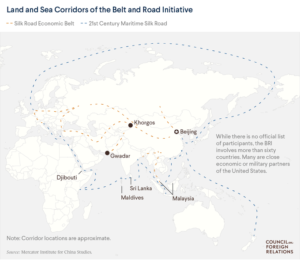In News
The Belt and Road Initiative, reminiscent of the Silk Road, is a massive infrastructure project that would stretch from East Asia to Europe. China’s colossal infrastructure investments may usher in a new era of trade and growth for economies in Asia and beyond. But skeptics worry that China is laying a debt trap for borrowing governments.
Features of Belt and Road Initiative
- Launched in 2013 by President Xi Jinping, the vast collection of development and investment initiatives would stretch from East Asia to Europe, significantly expanding China’s economic and political influence.
- The original Silk Road arose during the westward expansion of China’s Han Dynasty (206 BCE–220 CE), which forged trade networks throughout what are today the Central Asian countries of Afghanistan, Kazakhstan, Kyrgyzstan, Tajikistan, Turkmenistan, and Uzbekistan, as well as modern-day India and Pakistan to the south. Those routes extended more than four thousand miles to Europe.
- The plan is two-pronged: the overland Silk Road Economic Belt and the Maritime Silk Road.
- Xi’s vision included creating a vast network of railways, energy pipelines, highways, and streamlined border crossings, both westward—through the mountainous former Soviet republics—and southward, to Pakistan, India, and the rest of Southeast Asia.
- In addition to physical infrastructure, China plans to build fifty special economic zones, modeled after the Shenzhen Special Economic Zone.
- To accommodate expanding maritime trade traffic, China would invest in port development along the Indian Ocean, from Southeast Asia all the way to East Africa and parts of Europe.
- China has both geopolitical and economic motivations behind the initiative.
- Xi has promoted a vision of a more assertive China, while slowing growth and rocky trade relations with the United States have pressured the country’s leadership to open new markets for its goods.
- Promoting economic development in the western province of Xinjiang, where separatist violence has been on the upswing, is a major priority, as is securing long-term energy supplies from Central Asia and the Middle East, especially via routes the U.S. military cannot disrupt.
Backlash Against China
- The Belt and Road Initiative has also stoked opposition. For some countries that take on large amounts of debt to fund infrastructure upgrades, BRI money is seen as a potential poisoned chalice.
- BRI projects are built using low-interest loans as opposed to aid grants. Some BRI investments have involved opaque bidding processes and required the use of Chinese firms. As a result, contractors have inflated costs, leading to canceled projects and political backlash.
- Some governments, in places such as Kenya and Zambia, are carefully studying BRI investments before they sign up, and candidates in Malaysia have run—and won—campaigns on anti-BRI platforms.
- India has tried to convince countries that the BRI is a plan to dominate Asia, warning of what some analysts have called a ‘String of Pearls’ geoeconomic strategy whereby China creates unsustainable debt burdens for its Indian Ocean neighbors in order to seize control of regional choke points.
- In particular, New Delhi has long been unsettled by China’s decades-long embrace of its traditional rival, Pakistan. Meanwhile, India has provided its own development assistance to neighbors.

















